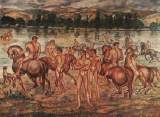

The group of The Eight was the first group in Hungarian art which represented modern trends in art. It was, however, only of a short life (1909-12). Their counterparts in literature were writers of the journal Nyugat or Béla Bartók and Zoltán Kodály in music. They attempted to adjust fine arts to trends of the age. The foundation and later exhibitions of the group were welcomed by the most progressive Hungarian publicists, but their works were popular with liberals in society appearing after 1905 who had the means to acquire pictures. The art of the The Eight represented a radicalism versus impressionism, a search for new ideas and Western orientation. The majority of its members had spent a long time in Paris. In 1908 they used the symbolic name Searchers, which they changed to The Eight after the exhibition in 1911.
Károly Kernstok was a distinguished personality of the group. His oeuvre and writings indicate his true commitment to searching for something new. Kernstok who used to be a pupil of Simon Hollósy in Munich did not follow his master to Nagybánya. The picture Teasing (1900) shows the influence of Károly Ferenczy's plein-air naturalism. It is directly related to Plum Pickers painted a year before which indicates his attraction to colourful and decorative compositions. Riders on the Shore, a large scale painting, is his main work (1910). Plein-air background and figures more delicately drawn demonstrate the change in his style.
As opposed to Kernstok, many of the neos with a Nagybánya background joined the The Eight. Béla Czóbel used to learn under Béla Iványi Grünwald in Nagybánya but his works were exhibited in Salon d'Automne in Paris, in the exhibition hall of the "Wild" of the French, as early as 1905. Then he worked in the art school of Károly Kernstok in Nyergesújfalu in 1907-08. The Portrait of Béla Czóbel (1907), a portrait by Kernstok, dates from that time. Early works of Czóbel were characteristic of a noisy style, but a softer, more intimate one appeared later while he still retained strong contours (Mask and Mandolin, 1922).
Perhaps the most significant figure of the group was Lajos Tihanyi who worked in Nagybánya in 1907-08. Streets in Nagybánya, and Landscape, two pictures founded on the contrast of prime colours, date from the year 1908. His later works were typical of the constructive definition of forms, plasticity and intensive colours (Female Portrait, 1921). In the 1910s he joined activism and had his first exhibition on his own with the journal MA in 1918.
The third artist with Nagybánya background was Dezső Czigány. He was a close friend of Endre Ady, a poet of the journal Nyugat (West) (Ady, 1907). Several of his portraits indicate a rather gloomy, sometimes even worried mood (Self-Portrait, 1910). His decorative landscapes are worth mentioning, and so are still-lifes reflecting the influence of Cézanne.
Ödön Márffy was a real master of colours, his early constructivist compositions were accompanied by intimate pictorial qualities (Constructivist Self-Portrait, 1914). His choice of colours influenced by that of Matisse was later replaced by a more lyrical approach. Female figures, delicate and airy (Csinszka, Zdenka Ticharich), and scenes by water appeared in the 1920s.
Róbert Berény, a great lover of music, painted the portrait of Béla Bartók in 1913. The early period of his art was characteristic of composition in the style and colours of Cézanne (Reclining Nude, 1907). Due to his political commitment to the left, he took an active part in the Hungarian Soviet Republic in 1919: the most famous poster to mobilise people to defend the country was produced by him (To Arms!).
Early pictures of Bertalan Pór reflected the influence of the Munich Academy, and later that of Simon Hollósy (Self-Portrait, 1902). He preferred plastic composition to colours. In his decorative-symbolic pictures, he attempted to reflect the new Weltanschauung of the society (Sermon on the Mount, 1911).
Dezső Orbán was a follower of all styles during his long life. Initially, he was influenced by Róbert Berény. Besides landscapes in the style of the Fauves (Churchyard, 1908), he painted excellent still-lifes reflecting the influence of Cézanne (Still-Life, 1911). His later pictures which showed streets in Paris were covered with a thick layer of paint as if a coat of plaster. At the end of his life, he tried his hand at calligraphy.